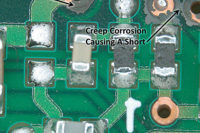
Figure
1. The
Energy Star process including the use of the TargetFinder and
Portfolio Manager online tools.
You’re designing a data center. Which certification makes the most sense? Do you really know how ASHRAE 90.1 does (or doesn’t apply) to your project? Where have the mission critical bigwigs put their focus? Develop perfect pitch for the differences involved and see why the author prefers to play in the key of ENERGY STAR.
About four years ago, I began the design of a data center. We started off with high hopes and a goal of LEED® Silver under Version 2.2. Early in the design phase, USGBC moved the goal posts by raising the minimum energy performance criteria, shifting from meeting ASHRAE 90.1 to beating it by 14%. Because my data center was a true data center with a high process load dominating the total, my objective of certification was put in jeopardy.
When we called USGBC for relief, they assured me that they felt my pain. They understood that one consequence of the change would be large process-driven projects like data centers may have to opt out of certification. But that loss was outweighed by the benefits of the increased efficiency that would be seen in the vast majority of their applications, such as office buildings and schools. To my chagrin, they basically told me to love it or leave it.
And thus began my four year quest to beat the round peg that is a data center into the stubbornly square hole called LEED.
Now before I dive in, as always, I preface my remarks by heartily congratulating those designers who have provided LEED data centers under NC v2.2 and now 3.0. It can be done, it has been done, and it will be done again. And when the USGBC finally gets around to issuing their version of LEED for Data Centers, I am sure it will be a hit. But that doesn’t mean I am or will be comfortable with what I feel is an inappropriate labeling program for data centers.
Basically, bamboo and bike racks just don’t fit into my vision of what makes a data center green.
STIRRING UP ALREADY MUDDY WATER
There are a lot of things that frustrate me about LEED, but it all boils down to ASHRAE 90.1. This standard is used to establish the baseline for the calculations that support the critical Energy and Atmosphere Credits needed for certification. The first hint of trouble when applying 90.1 to data centers can be found in the standard itself. Section 2.3.c (on page 1, no less) states,“The provisions of this standard do not apply to equipment and portions of building systems that use energy primarily to provide industrial, manufacturing or commercial processes.”
Now that might seem clear enough, but somehow we keep applying the standard to data centers, which are clearly dedicated to “commercial process.” ASHRAE has actually offered interpretations and clarification regarding data centers and the applicability of the standard (which, by the way, does not apply to data centers). Confused?
And now, if that weren’t enough fun, ASHRAE is trying to provide clarification and prescriptive requirements for data centers to the standard. Smarter guys than me can explain it all, but it all starts to feel too much like a through the looking-glass experience. For goodness sake, is the Mad Hatter on the technical committee?
But God love ’em, the data center industry bigwigs have pushed back and essentially said thanks, but no thanks. Specifically, in February 2010, representatives from the industry, including Green Grid, Google, Microsoft, Nokia, and Amazon issued their “Harmonizing Global Metrics for Data Center Energy Efficiency” statement, which summarized the agreement between data center industry consortiums in the U.S., Europe, and Japan to designate power usage effectiveness (PUE) as the industry’s preferred energy efficiency metric1.
Further, in April it was announced that the Green Grid had established an EPA ENERGY STAR Program Management Office. The offices aim was to “position the consortium as a trusted technical advisor to the U.S. EPA’s ENERGY STAR program.”2
AND NOW FOR SOMETHING COMPLETELY DIFFERENT
So after years of prodding and pushing, a major segment of the IT industry has collectively stepped away from LEED and has lined up behind PUE instead of 90.1 as a metric. And in so doing, it has affiliated with the EPA - which, it should be noted, is an agency that has no financial stake in the outcome (unlike the USGBC).The EPA has been incredibly successful with the marketing of the Energy Star program. While only building folks really understand LEED, average guys and gals out there get the Energy Star program. They see it when they buy a refrigerator, water heater, or new storm windows. And even though they may not understand the math behind it, they accept it as a mark of excellence. And if they walked into a lobby and saw that ubiquitous logo, they would understand they were in a special building.
But even though the Energy Star program for buildings has been out there for awhile, it hasn’t caught on like LEED. And that’s partly because LEED has been marketed better, but it’s also due to the fact that LEED provides a truly integrated approach to sustainability that is more applicable to typical buildings. Energy Star is an energy-centric approach, while LEED is more holistic and, in turn, a superior labeling system for typical buildings.
But data centers are different. And what the EPA has done by embracing PUE and working with the industry is to provide a more applicable labeling process for buildings that are, in fact, energy-centric. And at the risk of using one too many Disney movie metaphors, Energy Star feels like the green glass slipper that finally fits our data center’s proverbial foot.
In June of this year, the EPA announced the data center program3. The initiative covers IT equipment in addition to the buildings themselves. And, while our interest is focused on the data center proper, you can find everything you need, including the relevant history behind the initiative (including the infamous 2007 EPA report4that started it all), at their website.5
DELAYED GRATIFICATION
For starters, this is not a modeling process - this is based on real-world data. And that’s good news because one of the raps on LEED is that real-world energy performance has not been matching up to predicted performance. LEED and ASHRAE have recognized this and are working to address it. In fact, this disconnect is the primary impetus behind the ASHRAE Energy Quotient (EQ) Program currently in development.But one challenge you have will be convincing owners that what you are doing now will lead to a label later. The LEED process can lull a team into a false sense of security where we tend to believe we have a label in the bag even before the building is built. “We’re OK … the checklist says so, right?” But anyone who has been through a LEED audit knows it ain’t over ’til it’s over, especially as it pertains to the energy model and associated credits.
However, you can apply for the “Designed to Earn the ENERGY STAR” designation.6 You must become an Energy Star Partner (it’s free), use the EPA’s online Target Finder tool to rate the energy efficiency of the design, then complete and submit the appropriate documentation. The great thing about this is that this effort may allay the owner’s fears, since it will give them something to point to when the boss asks for proof of intent. It also tees you up for the ultimate goal of benchmarking and labeling post-occupancy.
As far as getting that final label, the process is pretty straightforward. It requires using the EPA’s online Portfolio Manager tool in addition to submitting the required documentation. And if you think that the additional energy management design and documentation requirement is some sort of onerous burden, you need to recognize that if you aren’t providing the means to monitor, manage, and document energy performance, you probably aren’t qualified to design a data center in the first place.
OF MODELS AND METERING
While the issue of timing may present a political problem, it should have no bearing on the design process. You are still going to design to provide the most efficient building possible. And the modeling is still required so that you have an accurate predictor of relative performance. Just like the computation fluid dynamics (CFD) modeling of the data hall, you have to know that the direction you are going is the right direction. Modeling is never perfect, but it beats guesswork.What makes the Energy Star process preferable is the harsh reality that models are order of magnitude predictors at best. If you really believe you should award credits based on a percentage point difference on a model alone - with literally hundreds of variables, dozens of which are at the discretion of the individual modeler - then your faith in the process borders on the evangelical.
Even the GSA recognizes the limits of modeling and says as much in “P100, Section 1.8 - Life Cycle Costing,” stating in part, “due to possible margins of error in estimating costs, alternatives with a life cycle cost differential of less than 10 percent can be judged inconclusive by GSA.” Granted, there are more variables in a life cycle model than a pure energy model alone, but you get the point: You can hang your hat on historical data, even if you do have to wait a year for it.
And at the risk of coming across as way too cynical for a man my age, I would contend that LEED rewards creative and aggressive modeling while Energy Star rewards performance.
Finally, if you can get the players to understand the process, you actually introduce an opportunity to officially stay engaged with the project for the first year of operation. Not to sound crass, but a good salesman can offset the loss in design revenue that LEED documentation requires with fees associated with monitoring and documenting performance. And isn’t it of more value to the owner to have you engaged - and on the hook - for that first year?
I would suggest you would gain more from this hand-in-hand arrangement than you would filling out on-line forms and massaging and/or defending modeling assumptions.
ISN'T IT IRONIC?
Irony is defined as “incongruity between what actually happens and what might be expected to happen, especially when this disparity seems absurd or laughable.” If that’s the case, how’s this for ironic: The biggest obstacle to a labeling program developed by a powerful and respected department within the U.S. government are mandates from other powerful and respected departments within the U.S. government.Hey, I’m laughing so hard it hurts.
If you have worked with the government of late, you know there are hard and fast rules regarding energy performance and LEED, in particular. Without listing every act and order here, I can tell you that depending on the project and agency, you may be required to beat 90.1 by 30% to 40%, and/or achieve LEED NC Certified or Silver, in addition to prescriptive requirements for solar water heating, solar arrays, and various renewable strategies.
What you likely won’t find anywhere in those mandates is a reference to PUE.
And while I think you can sway an owner to Energy Star in the private sector, I am convinced you will only find frustration if you pursue it with a government project, be it federal, state, or local. And the reason is the sheer inertia of bureaucracy. Put bluntly, you just can’t fight City Hall.
While a data center operator can grasp and even embrace the energy-focused Energy Star program, the paper-pusher up the chain never will. Ultimately, it comes down to those very acts and orders. You can ask the Under-Secretary of Facilities, Logistics and Ball Point Pens to break the law, but he won’t. And if it were your job, you wouldn’t, either.
So the best-case scenario for government projects is either that LEED will get off the dime and issue LEED for Data Centers sometime in our lifetime, or the federal agencies will adopt the Environmental Performance Criteria Guide for New Data Centers7 developed by the Lawrence Berkeley National Laboratory (ironically part of another respected agency). I suspect that some government projects have been able to do the latter, but I’m not privy to every mission critical project in the country, so obviously it’s speculation on my part.
IN CONCLUSION
Midway through my career, I jumped companies to follow a very charismatic leader. You could say that I hitched my wagon to Mike’s star. Eighteen months later, Mike was canned and I was orphaned. So my track record for picking winners isn’t 100%. But as the country-western song says, you have to stand for something, or you will fall for anything.It’s a given that the challenge in our industry is that technology is evolving so fast that settling on a labeling program is difficult. For example, how would 90.1 and, in turn, LEED, ever apply to a containerized data center?
But today, I’m standing for hitching my wagon to Energy Star. And why? Because:
- It is focused on energy, which is the bane of data centers;
- It is a readily recognized and accepted brand in the marketplace;
- It is based on PUE, which is the industry standard for performance measurement;
- And, because nothing else exists or is on the immediate horizon that matches it in legitimacy, recognition, or applicability.
And if the project has to go for LEED, buckle up, get out your hammer, and drive that peg into that gosh darn hole. Good designers can get a label with either system, and either way, you will be a star.
Ed McMahon would be proud.ES
CITED WORKS
1.www.energystar.gov/ia/partners/prod_development/downloads/Harmonizing_Global_ Metrics_for_Data_Center_Energy_Efficiency.pdf .2.www.datacenterknowledge.com/archives/2010/04/05/pue-goes-global/.
3.http://yosemite.epa.gov/opa/admpress.nsf/0/810cb77be1d695a58525773b004ed344 .
4. EPA. “Report to Congress on Server and Data Center Energy Efficiency Public Law, 109-431” August 2, 2007.
5.http://www.energystar.gov/index.cfm?c=prod_development.server_efficiency#rating .
6.www.energystar.gov/index.cfm?c=cbd_guidebook.cbd_guidebook_apply_1 .
7.http://hightech.lbl.gov/dc-epc.html .



